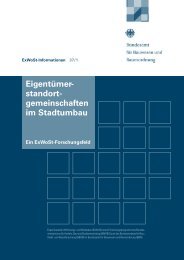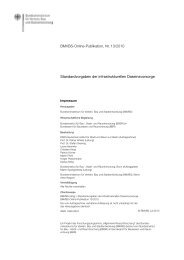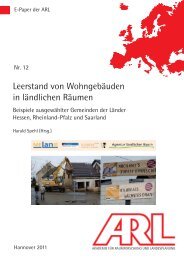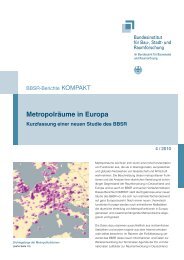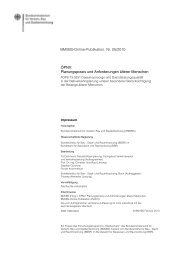Download - Fachgebietes Ãkonomie des Planens und Bauens ...
Download - Fachgebietes Ãkonomie des Planens und Bauens ...
Download - Fachgebietes Ãkonomie des Planens und Bauens ...
Erfolgreiche ePaper selbst erstellen
Machen Sie aus Ihren PDF Publikationen ein blätterbares Flipbook mit unserer einzigartigen Google optimierten e-Paper Software.
12<br />
Summary<br />
wider urban development context. However, smaller<br />
towns sometimes have problems in managing the complex<br />
set of different financial resources. The financial<br />
settlement from the property owners is one of the most<br />
delicate issues in the management of the regeneration<br />
process. Good examples show that the settlement can<br />
be implemented successfully but with a lot of effort. A<br />
key precondition for success is early, transparent and<br />
comprehensive information of the owners in the redevelopment<br />
area.<br />
Regeneration procedures result in various positive<br />
effects that sometimes come up even before they are<br />
completed and they are often stable thereafter. Among<br />
them are urban development, image and functional<br />
effects and organizational learning that can be used for<br />
other local policies. However, the effects cannot easily<br />
be isolated from overall trends in urban development.<br />
They are threatened by economic and demographic<br />
crises locally. Especially the mega-structures that have<br />
been integrated into the urban fabric in the 1970s are<br />
often very fragile and create reasons for belated rectification<br />
measures.<br />
Urban regeneration measures play a central role in<br />
contributing to making inner cities of all sizes sustainable.<br />
They were partly responsible for allowing for<br />
an adaptation to a car-dominated, service industry<br />
based and life-style oriented society. Thus, they laid<br />
the fo<strong>und</strong>ation for an “urban renaissance”. Some of<br />
the essential elements of the careful strategies that<br />
have proved their worth until today are the successful<br />
adaptive reuse of non-residential buildings as a contribution<br />
to vibrant neighbourhoods, a quality-oriented<br />
approach towards the planning of public space, traffic<br />
calming combined with an improvement of access and<br />
the creation of alternative housing options in carefully<br />
integrated new buildings.<br />
Important economic effects besi<strong>des</strong> the promotion<br />
of local craftsmanship and the construction sector<br />
are the stabilization of the traditional retail areas in<br />
downtown, an increase in attractiveness for visitors<br />
and the stimulation of alternative economies in the<br />
service sector. They depend strongly on the size if the<br />
city and the economic environment. Although redevelopment<br />
areas can hardly ever be considered important<br />
job centers, the economic effects of the regeneration<br />
process should not be <strong>und</strong>erestimated. They are not<br />
self-evident, though, and they are highly dependent on<br />
a consistent urban development strategy. Particularly<br />
middle-sized towns have seen reactions to changes in<br />
the retail sector in trying to stabilize the main inner-city<br />
retail centers that have seen major investment during<br />
the regeneration process.<br />
In big cities, urban regeneration could contribute to<br />
social cohesion. Strategies that take social housing<br />
seriously, provide a wide range of housing options and<br />
carefully upgraded the existing housing stock were particularly<br />
successful. However, lately the urban planning<br />
regulations do not provide powerful safeguards against<br />
gentrification anymore when inner cities witness an<br />
overall increase in attractiveness and after the regeneration<br />
process has been completed. However, regeneration<br />
policies are not clearly accountable for symptoms<br />
of gentrification. Sometimes, they rather buffered the<br />
effects of gentrification. Former redevelopment areas<br />
are sometimes surprisingly socially mixed, but the gentrification<br />
accelerates when the social housing policies<br />
come to an end. On the other hand, there are neighbourhoods<br />
with negative image that can only be partly<br />
stabilized by upgrading measures. In middle-sized<br />
towns and less prominent parts of the cities, the regeneration<br />
strategies have to incorporate the contemporary<br />
housing needs and provide the respective supply for<br />
different social strata. In general, gentrification is less<br />
significant than in a few well-known bourgeois-bohemian<br />
neighbourhoods of big cities.<br />
Surprisingly, environmental effects of urban regeneration<br />
are hard to measure. They play a minor role in<br />
self-reporting of the cities. Nevertheless, urban regeneration<br />
contributes significantly to inner-city conversion<br />
and to an acceptance of compact housing not only by<br />
the addressees but also all sorts of stakeholders. High<br />
densities and a mix of functions were key factors in<br />
stabilizing a compact urban fabric, but they are by no<br />
means self-evident.<br />
Organizational learning in public administrations in governance<br />
arrangements would not have been so striking<br />
had it not been for the challenges posed by careful regeneration<br />
with a wide range of stakeholders, owners and<br />
inhabitants. The results were participatory approaches<br />
and a number of interesting instrumental organizational<br />
and management innovations that last until today<br />
and that are now sometimes part of the mainstream.<br />
Langzeitwirkungen <strong>und</strong> Effektivierung der Städtebauförderung








